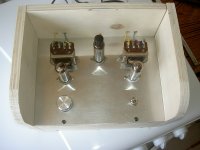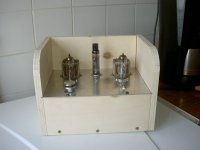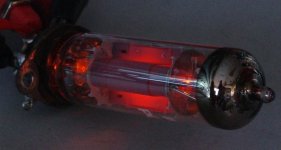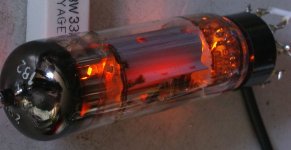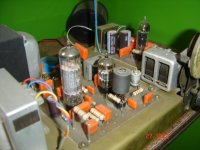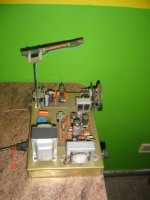I took a challenge in this post on whether a PCL805 run at its design maximum rating for plate dissipation (10.5 W) will glow red. The test I did was to tie grid and cathode together as well as the screen and plate and hook it up to a power supply fed through a variac. At 100 volts the TUT (Tube Under Test) drew 125 mA which is over the spec but allowing for the additional screen dissipation. It did not glow red. Foiled! Only at a total dissipation of 22 watts some redness began to show. By this time the poor tube was really hot.
So the conclusion is: it does not glow cherry red. Not even a little.
When it's dark I will post a picture of the abused tube glowing red. At way over the maximum plate dissipation...
So the conclusion is: it does not glow cherry red. Not even a little.
When it's dark I will post a picture of the abused tube glowing red. At way over the maximum plate dissipation...
The PCL805 have the same size plate as PCL86, but the thicknes is not the same!
PCL805 was constructed ~20 year after PCL86 with better materials.
PCL805 was constructed ~20 year after PCL86 with better materials.
That was not a challenge but merely a statement of well-known fact - ordinary TV valves were not designed to red-plate.Regenpak said:I took a challenge . . .
20 years? I very much doubt it. Perhaps 8 years. PCL805 was a more reliable replacement for PCL85, which had a reputation for short life as a frame output valve.davorin said:PCL805 was constructed ~20 year after PCL86 with better materials.
@DF96: Oh, I've seen'em red plate allright! Of course in a fault situation, but still...
In any case, the results are in. I'd say it's a tie, judge for yourself. Both tubes were grossly overdriven with about 22 W plate and screen dissipation. Did notice that the PCL805 needed much less voltage than the PCL86 which makes sense with the latter being intended for audio purposes and the '805 for field output stages. Oh, I tested just one '805 and two PCL86s. Took two shots of the PCL805.
In any case, the results are in. I'd say it's a tie, judge for yourself. Both tubes were grossly overdriven with about 22 W plate and screen dissipation. Did notice that the PCL805 needed much less voltage than the PCL86 which makes sense with the latter being intended for audio purposes and the '805 for field output stages. Oh, I tested just one '805 and two PCL86s. Took two shots of the PCL805.
Attachments
Last edited:
A propos year: both datasheets (Philips, TFK) were dated 1969. I do have the impression that the PCL805 handles overload slightly better than the PCL86 but not by much.
@jean michel: nice little amp!
@jean michel: nice little amp!
Pentode sistem in PCL86(ECL86) is the same as EL41 and EL80, but pentode sistem in PCL805(and PCL85) is recent construction. PCL85 was constructed for BW-TVset with screen diagonal of 59-61cm (PCL82 was for 53-57cm!) and work fine there, but did not work well with bigger screen (66cm). New, stronger and longer life tube was PCL805, and used successfully in some ColorTV-sets with screen diagonal of 66cm.
No conventionally gettered receiving tube should glow red at its design maximum ratings or even slightly beyond the maximums. Some poorly designed or manufactured tubes might show a localized hot spot. If they do they will have a short lifespan.
I have been torturing tubes since I was about 10 years old, and this has held up.
Some of the early Chinese tubes were particularly bad. The KT88's from about 15 years ago would red plate at 25 watts. I have also seen random examples of US manufactured tubes from near the end of production that were so grossly misaligned that all the current flowed through a small localized area causing a bright red spot on the plate while the rest of the plate was cold. These are anomalies.
Regenpak, your pictures reveal well constructed tubes. The redness is even and well distributed.
I have been torturing tubes since I was about 10 years old, and this has held up.
Some of the early Chinese tubes were particularly bad. The KT88's from about 15 years ago would red plate at 25 watts. I have also seen random examples of US manufactured tubes from near the end of production that were so grossly misaligned that all the current flowed through a small localized area causing a bright red spot on the plate while the rest of the plate was cold. These are anomalies.
Regenpak, your pictures reveal well constructed tubes. The redness is even and well distributed.
@tubelab.com: they do indeed and they should as all of them are Philips built.
@davorin: is your insight based on fact (aka datasheet) or anecdotal? EL84 is a replacement for EL41 (EL80 does not exist) but I maintain that ECL85 is a tube intended for pulse operation. Which in itself is not a bad thing (PL519, anyone?) but ECL86 is not an equivalent for EL84 (or EL41 for that matter). It can never be, its anode is much smaller to accommodate the triode and hence its maximum plate dissipation 3/4 of the EL84. Also, the ECL85 datasheet I found in Frank's excellent collection is from 1961 wheras the ECL86 is from 1969. Still it's a pity the bases differ as a PCL8(0)5-86 shootout would be absolute fun!
Edit: EL80 does exist, and is a direct replacement for EL41. It is also very rare.
@davorin: is your insight based on fact (aka datasheet) or anecdotal? EL84 is a replacement for EL41 (EL80 does not exist) but I maintain that ECL85 is a tube intended for pulse operation. Which in itself is not a bad thing (PL519, anyone?) but ECL86 is not an equivalent for EL84 (or EL41 for that matter). It can never be, its anode is much smaller to accommodate the triode and hence its maximum plate dissipation 3/4 of the EL84. Also, the ECL85 datasheet I found in Frank's excellent collection is from 1961 wheras the ECL86 is from 1969. Still it's a pity the bases differ as a PCL8(0)5-86 shootout would be absolute fun!
Edit: EL80 does exist, and is a direct replacement for EL41. It is also very rare.
Last edited:
hello ,
have to redo a modification on the part ampli meadow, I would make a definitive plan of l ampli, on the other hand I n have not to find d equivalence on the parts triode and penthode of this tube, so about one can give me equivalence !
good day for alls 😉
have to redo a modification on the part ampli meadow, I would make a definitive plan of l ampli, on the other hand I n have not to find d equivalence on the parts triode and penthode of this tube, so about one can give me equivalence !
good day for alls 😉
EL84 is not good replacement for EL41, maybee successor. Pentode sistem(see data sheet!) of ECL86 (PCL86) is almost identical with EL41.@tubelab.com: they do indeed and they should as all of them are Philips built.
@davorin: is your insight based on fact (aka datasheet) or anecdotal? EL84 is a replacement for EL41 (EL80 does not exist) but I maintain that ECL85 is a tube intended for pulse operation. Which in itself is not a bad thing (PL519, anyone?) but ECL86 is not an equivalent for EL84 (or EL41 for that matter). It can never be, its anode is much smaller to accommodate the triode and hence its maximum plate dissipation 3/4 of the EL84. Also, the ECL85 datasheet I found in Frank's excellent collection is from 1961 wheras the ECL86 is from 1969. Still it's a pity the bases differ as a PCL8(0)5-86 shootout would be absolute fun!
Edit: EL80 does exist, and is a direct replacement for EL41. It is also very rare.
Internal resistance and optimum plate load of xCL86 is much higher than xCL805. For optimum suiting xCL86 (push-pull, maximum output power) need Raa=9,1kOhm (Ub=300V, Pout=13,6W from Philips data), and for xCL805 is much lower Raa=5kOhms (Ub=250V, Pout=17W).
In attach. is data sheet from Japanese VADE-MECUM for tube ECL85(6GV8).
Attachments
PCL85 is a very different tube , much better build , and usually last much longer in the same TV as vertical amplifier than PCL86 as audio amplifier ... If you look at them , the cathode of PCL85 is allmost twice in size ( thickness and surface for emission ) .
Well, that makes perfect sense as it's intended for high current pulse operation (up to half an amp!) but at a much lower plate voltage. So if you use it with Raa=10k like you would with EL84 (or PCL86 for that matter) it won't perform as well. You need a lower plate voltage (200 V) and lower Raa (maybe 5k or even less) to make it perform in its optimal working condition. Otherwise the larger surface area of the cathode isn't utilized.
ECL85 is a good audio stage . I saw it in lots of record players (Cheap ones), and I used it successfully for my regenerative AM receiver. The advantage of this pentode is its lower voltage needed to properly work in audio (No more than 170V, as it becomes red hot) and higher current making lower output impedance and then lower turns ratio in the output transformer.
Attachments
Last edited:
Pentode sistem in PCL86(ECL86) is the same as EL41 and EL80,
Agreed!
but pentode sistem in PCL805(and PCL85) is recent construction. PCL85 was constructed for BW-TVset with screen diagonal of 59-61cm (PCL82 was for 53-57cm!) and work fine there, but did not work well with bigger screen (66cm). New, stronger and longer life tube was PCL805, and used successfully in some ColorTV-sets with screen diagonal of 66cm.
Please note that there's no relation between power requirements for the frame output stage and valve on one hand and the CRT's size on the other! The frame output power only depends on the deflection angle and the CRT's neck diameter.
In my youth I've owned a Telefunken FE 25/59 b/w tv set, built around 1960, 110° deflection, 59 cm screen size, which featured the PCL82 as the frame deflection tube and the PCL86 as the AF amplifier.
According to a Telefunken source (Telefunken Laborbuch vol. 3, p. 196f., in German), the main reason for introducing the PCL85 as a functional replacement for the PCL82 was to decrease the frame output transformer's size and production costs.
Best regards!
the main reason for introducing the PCL85 as a functional replacement for the PCL82 was to decrease the frame output transformer's size and production costs...
Best regards!
... because it has higher current capability at a lower plate voltage, maintaining the power manageable by the tube.
This is perfectly demonstrated with my redplating experiments. Both tubes were set to dissipate 22 watts. The PCL85 only needed 120 V whereas the PCL86 ended up close to 200 volts.
Erm, I've been speaking of the PCL82! The PCL86 never has been intended for use as a frame amplifier.
Best regards!
Best regards!
- Status
- Not open for further replies.
- Home
- Amplifiers
- Tubes / Valves
- Does a PCL805 glow red at its maximum rating?
